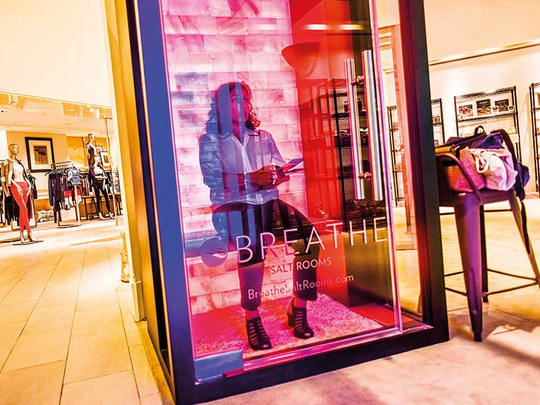
I entered a neon-lit chamber the size of a phone booth and sat on the bench as instructed.
Pink Himalayan salt bricks formed the walls, and pink salt crystals crunched beneath my shoes. As the mood lighting changed from fuchsia to gold, hidden speakers piped in birdsong and gentle piano music. Soon, a fine mist of 99 per cent sodium chloride filled the air, dispersed from a device called a halogenerator.
It was my first treatment in a salt room, and perhaps the only thing more unusual than the experience was its location: I was at Saks Fifth Avenue’s ornate flagship store in the heart of Manhattan’s shopping district. I had wandered into Saks hoping to learn how a venerable department store was dealing with the upheavals throttling the retail industry.
As stores around the US reckon with Amazon.com, discount chains and changing consumer habits, they are turning to “experiential” offerings that entice people to enter their doors. Saks, I figured, would be trying out some new concepts of its own. But I was unprepared for what I found on the second floor.
There, spread across 16,000 square feet that until recently displayed ready-to-wear Armani and Burberry, was what Saks is calling The Wellery. An ad hoc assortment of upscale fitness products and unusual New Age remedies, The Wellery features kiosks offering avocado juice and futuristic fat removal processes.
It also has group fitness classes taught by ex-convicts and vegan non-toxic nail treatments that promise to “help with focus, memory, increased confidence and overall wellness”. A few days after my visit to the salt room, I was back at The Wellery with Marc Metrick, the president of Saks.
“The wellness thing is big,” he said, strolling the floor as employees prepared to greet the day’s first customers. “We’re calling it “the new luxury”. It used to be about fur and leather. But people just want to feel better.”
Precisely what makes people feel better these days can be surprising. One section of The Wellery is devoted to ConBody, a “prison-style boot camp” that features ex-convicts leading workouts for $30 a class. The ConBody studio, sheathed in chain link fencing and faux cinder block wallpaper, is across the aisle from the Martone Cycling Co., which sells brightly coloured two-speed bicycles that cost $1,200.
Nearby was Sundays, a nail studio that offers guided meditation along with its manicures. And around the corner was Skinney Medspa, a boutique offering “non-invasive body contouring” treatments like CoolSculpting, a weight-loss treatment that freezes fat cells away.
Saks isn’t the first department store to sell wellness treatments alongside haute couture. Nordstrom, the high-end department store chain based in Seattle, has a line of spas offering acupuncture, massages and a treatment billed as a “oxygen boosting facial with skin detox” for $180. Macy’s and Saks both have partnerships with Purebeauty Salon & Spa, a chain offering manicures, massages and waxing.
And in some ways, the new effort is a return to the past. Some 80 years ago, Saks was a pioneer in creating eye-catching retail experiences. In 1935, the department store built an indoor ski slope where instructors offered lessons to customers while selling skis and winter wear. The new emphasis on wellness comes as Saks’ corporate parent is under siege.
An activist investor, Land & Buildings Investment Management, recently took a 4 per cent stake in Hudson’s Bay Co., which owns Saks and other department stores including Lord & Taylor. Land & Buildings added pressure, issuing a letter that suggested Hudson’s Bay sell Saks Fifth Avenue.
Absent a sale, the investor called on the company to turn the upper floors of the flagship store into high-end residential condos. There are no plans to convert Saks’ flagship into apartments just yet, but Metrick and his team are overseeing a major overhaul of the store. The first floor, currently occupied by make-up and perfume kiosks, is being turned over to leather goods and accessories.
Beauty and fragrances will be moving to the second floor next year. The renovation plan originally called for the second floor to sit empty for much of this year. But Metrick challenged his executive team to come up with a creative way to use the space.
“Selling stuff in stores is not the answer,” he said. “You have to build an emotional connection with them. Where else can you take a fitness class and buy a Chanel handbag?”
It isn’t clear how many of Saks’ discerning clientele are actually interested in getting a lemon scrub after purchasing a $5,100 Alexander McQueen dress. During multiple visits over the past week, The Wellery was sparsely populated.
At HFactor, a counter selling hydrogen-infused water, there were no customers to be seen, only a saleswoman idly pecking on her iPhone. A nearby boutique, featuring expensive TechnoGym workout equipment for sale, was similarly devoid of guests. Many shops were altogether unstuffed.
Metrick seemed undeterred, however, and said there would be more wellness services to come. In the coming weeks The Wellery will install a Somadome pod, a device that Saks says “uses LED colour therapy, binaural beat meditation, and energy healing microcrystalline tiles for optimal restoration.”
And while The Wellery will be dismantled later this year as part of the renovations, Metrick said elements of the experiment will be incorporated throughout the redesigned flagship.
“This isn’t the end of wellness for us,” he said. For example, plans for the remodel of the flagship store include a permanent juice bar on the fifth floor.
“Juice bars today are what frozen yoghurt was in 2003,” Metrick said.
New York Times News Service












